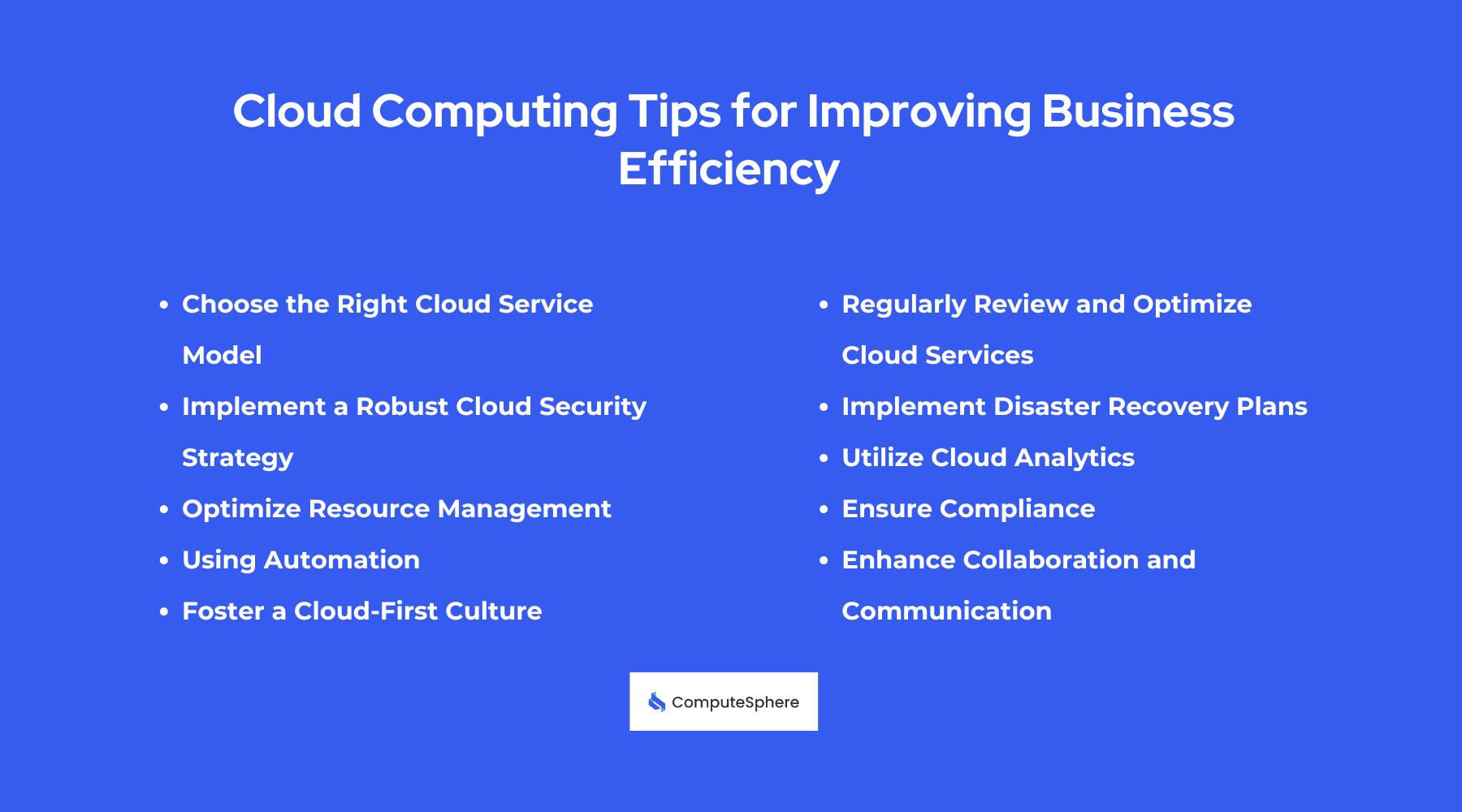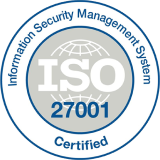Top 10 Cloud Computing Tips for Improving Business Efficiency in 2024

Cloud computing has become an important part of businesses aiming to enhance efficiency, streamline operations, and drive growth. With cloud technologies, companies can access powerful computing resources, reduce costs, and improve collaboration. Here, we discuss practical tips on how you can harness the power of cloud computing to boost your business efficiency.

1. Choose the Right Cloud Service Model
Selecting the appropriate cloud service model is very important for maximizing efficiency. There are three primary models to consider: Infrastructure as a Service (IaaS), Platform as a Service (PaaS), and Software as a Service (SaaS).
IaaS provides virtualized computing resources over the internet. It’s ideal if you need control over your infrastructure but want to avoid the costs of physical hardware.
PaaS offers a platform for developing, testing, and deploying applications without managing the underlying infrastructure. It’s great for development teams focusing on building and deploying applications.
SaaS delivers software applications over the internet on a subscription basis. This model is perfect for accessing essential applications without worrying about maintenance and updates.
By choosing the right model for your needs, you can streamline operations and reduce overhead.
2. Implement a Robust Cloud Security Strategy
Security is a top concern for businesses adopting cloud computing. A robust security strategy protects data and enhances efficiency by preventing disruptions.
Use Multi-Factor Authentication (MFA)
MFA adds an extra layer of security, making it harder for unauthorized users to access your cloud services.
Regularly Update Security Protocols
Stay ahead of threats by regularly updating your security measures. This includes installing patches, updating software, and reviewing security policies.
Encrypt Data
Encrypt your data both in transit and at rest. This protects sensitive information from unauthorized access.
By prioritizing security, you can protect your assets and maintain smooth operations.
3. Optimize Resource Management
Efficient resource management is key to maximizing the benefits of cloud computing. Here are some strategies to consider:
Auto-Scaling
Use auto-scaling to adjust resources based on demand. This ensures you’re not paying for unused capacity while maintaining performance during peak times.
Monitor Usage
Regularly monitor resource usage to identify underutilized resources. This helps you optimize costs and improve efficiency.
Implement Cost Management Tools
Many cloud providers offer cost management tools that provide insights into your spending. Use these tools to set budgets and track expenses.
By effectively managing your resources, you can reduce costs and ensure your cloud environment runs efficiently.
4. Using Automation
Automation can significantly enhance business efficiency by reducing manual tasks and streamlining processes. Here are a few ways to leverage automation in your cloud environment:
Automate Backups
Ensure data integrity and availability by automating backups. This reduces the risk of data loss and ensures quick recovery in case of an incident.
Automate Deployment
Use automation tools to streamline the deployment process. This reduces human error and speeds up the release of new features and updates.
Automate Routine Tasks:
Identify repetitive tasks that can be automated, such as software updates and system maintenance. This frees up your team to focus on more strategic initiatives.
By incorporating automation, you can improve efficiency and reduce the risk of errors.
5. Enhance Collaboration and Communication
Cloud computing provides numerous tools that enhance collaboration and communication within your team. Here are some tips to make the most of these tools:
Use Cloud-Based Collaboration Tools
Platforms like Google Workspace and Microsoft 365 offer robust collaboration features, including real-time document editing, video conferencing, and instant messaging.
Implement Project Management Software
Tools like Asana, Trello, and Slack can help your team stay organized and communicate effectively. These platforms streamline project management and improve workflow.
Encourage Cloud Adoption
Ensure all team members are comfortable using cloud tools. Provide training and resources to help them understand how to use these tools effectively.
By fostering a collaborative environment, you can improve productivity and streamline communication.
6. Regularly Review and Optimize Cloud Services
To maintain efficiency, it’s important to regularly review and optimize your cloud services. Here’s how you can do this:
Conduct Regular Audits
Perform regular audits of your cloud services to identify areas for improvement. This includes reviewing resource usage, security measures, and cost management.
Optimize Performance
Use performance monitoring tools to identify bottlenecks and optimize your cloud environment. This ensures your applications run smoothly and efficiently.
Stay Updated
Stay current with the latest cloud technologies and best practices. This will help you adopt new features and improvements that can enhance efficiency.
Regular reviews and optimizations ensure your cloud environment remains efficient and effective.
7. Implement Disaster Recovery Plans
You must have a robust disaster recovery plan to maintain business continuity and efficiency. Here are some steps to implement an effective plan:
Regular Backups
Ensure your data is regularly backed up to prevent data loss. Use automated tools to schedule backups and verify their integrity.
Test Your Plan
Regularly test your disaster recovery plan to identify potential issues and ensure it works effectively. This includes simulating different disaster scenarios and evaluating your response.
Document Procedures
Document all disaster recovery procedures and ensure your team is familiar with them. This ensures a right and organized response in case of an incident.
By preparing for disasters, you can minimize downtime and maintain operational efficiency.
8. Utilize Cloud Analytics
Cloud analytics tools can provide valuable insights into your operations, helping you make data-driven decisions. Here’s how to leverage these tools:
Monitor Performance Metrics
Use analytics tools to monitor key performance metrics, such as server uptime, response times, and user engagement. This helps you identify areas for improvement.
Analyze Usage Patterns
Analyze usage patterns to understand how your services are being utilized. This helps you optimize resources and improve efficiency.
Set Up Alerts
Configure alerts to notify you of any performance issues or anomalies. This allows you to address problems quickly and maintain service quality.
You can gain valuable insights and improve business efficiency by leveraging cloud analytics.
9. Ensure Compliance
Compliance with industry regulations is crucial for maintaining business efficiency and avoiding legal issues. Here’s how to ensure compliance in your cloud environment:
Understand Regulations
Familiarize yourself with the regulations that apply to your industry, such as GDPR, HIPAA, and PCI-DSS, and ensure that your cloud services comply with these requirements.
Use Compliance Tools
Many cloud providers offer compliance tools that help you monitor and manage compliance requirements. Use these tools to streamline compliance efforts.
Regular Audits
Conduct regular audits to ensure ongoing compliance. This includes reviewing security measures, data handling practices, and documentation.
By ensuring compliance, you can avoid legal issues and maintain efficient operations.
10. Foster a Cloud-First Culture
Creating a cloud-first culture within your organization can significantly enhance efficiency. Here are some tips to foster this culture:
Educate Your Team
Provide training and resources to help your team understand the benefits of cloud computing and how to use cloud tools effectively.
Encourage Innovation
Encourage your team to explore new cloud technologies and find innovative solutions to business challenges.
Lead by Example
Demonstrate your commitment to cloud adoption by using cloud tools and promoting their use within your organization.
By fostering a cloud-first culture, you can drive efficiency and innovation throughout your organization.
Conclusion
Cloud computing offers immense potential for improving business efficiency. By choosing the right service model, implementing robust security measures, optimizing resource management, enhancing collaboration, and regularly reviewing your cloud services, you can harness the full power of the cloud.
Additionally, implementing disaster recovery plans, utilizing cloud analytics, ensuring compliance, and fostering a cloud-first culture will further enhance your efficiency and position your business for success in the digital age.
Remember, the key to maximizing the benefits of cloud computing lies in continuous learning and adaptation. Stay informed about the latest trends and best practices, and be open to exploring new technologies and strategies. Doing so ensures your business remains agile, efficient, and competitive in an ever-evolving landscape.
Contents
Built for Builders. Priced for Startups.
Tired of unpredictable cloud bills? ComputeSphere offers modular, fixed-cost cloud hosting that grows with your startup—no DevOps headaches, no surprises.
Get StartedShare this article
Browse Some Related Blogs
Relevant and related contents you can read









